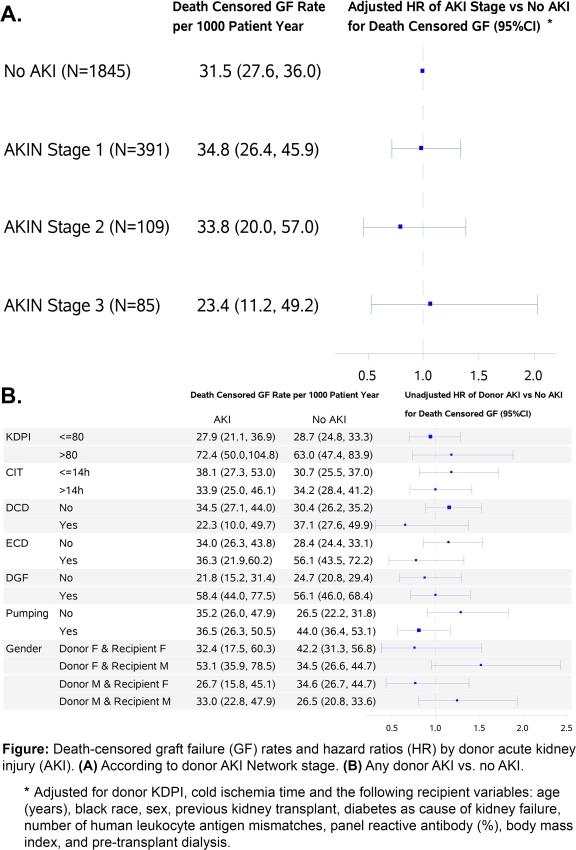Long-Term Kidney Transplant Survival after Deceased-Donor Acute Kidney Injury
Deceased Donor Study Consortium, New Haven, CT.
Meeting: 2018 American Transplant Congress
Abstract number: 321
Keywords: Donors, Kidney transplantation, marginal, Renal failure, Survival
Session Information
Session Name: Concurrent Session: Kidney Complications: Late Graft Failure
Session Type: Concurrent Session
Date: Monday, June 4, 2018
Session Time: 4:30pm-6:00pm
 Presentation Time: 5:30pm-5:42pm
Presentation Time: 5:30pm-5:42pm
Location: Room 6E
Purpose: Acute kidney injury (AKI) occurs frequently in deceased donors and is associated with organ discard. Prior studies indicate an association between donor AKI and delayed graft function (DGF), but sufficient data on longer-term allograft survival are lacking.
Methods: We performed a multicenter study to determine associations between donor AKI severity (AKI Network stages based on admission to terminal serum creatinine) and death-censored graft failure (GF). Key covariates for adjustment included the kidney donor profile index (KDPI, relative to all U.S. deceased donors in 2010); cold ischemia time (CIT); antigen mismatches; and recipient age, race, gender, body mass index, diabetes, panel reactive antibody, prior transplant and pre-transplant dialysis. We also analyzed several donor and recipient risk factors as potential effect modifiers on the relationship between donor AKI and allograft survival.
Results: Out of 2430 transplanted kidneys from 1298 donors, 585 (24%) were from donors with AKI. As shown in the Figure (panel A) and with a median follow-up of 3.7 years, the rates of GF per 1000 patient years were numerically lower for increasing stages of donor AKI. Kaplan-Meier curves, however, demonstrated no significant differences in graft survival by donor AKI stages. With no AKI as the reference, the Figure (panel A) also shows that adjusted hazard ratios for GF for donor AKI stages were modest and not statistically significant. Furthermore, panel B of the Figure shows no significant effect modification between donor AKI on graft survival based on KDPI (≤80 or >80), CIT (median cutoff, ≤14 h or >14 h), donation after cardiac death (DCD) status, expanded-criteria donor (ECD) status, development of DGF, use of machine perfusion (pumping), or donor or recipient gender.
Conclusions: Deceased-donor AKI was not associated with long-term graft failure in this multicenter cohort. The transplant community should pursue measures to increase utilization of kidneys from donors with AKI.
CITATION INFORMATION: Hall I., Akalin E., Bromberg J., Doshi M., Harhay M., Jia Y., Mansour S., Mohan S., Muthumkumar T., Reese P., Schröppel B., Singh P., Thiessen-Philbrook H., Weng F., Parikh C. Long-Term Kidney Transplant Survival after Deceased-Donor Acute Kidney Injury Am J Transplant. 2017;17 (suppl 3).
To cite this abstract in AMA style:
Hall I, Akalin E, Bromberg J, Doshi M, Harhay M, Jia Y, Mansour S, Mohan S, Muthumkumar T, Reese P, Schröppel B, Singh P, Thiessen-Philbrook H, Weng F, Parikh C. Long-Term Kidney Transplant Survival after Deceased-Donor Acute Kidney Injury [abstract]. https://atcmeetingabstracts.com/abstract/long-term-kidney-transplant-survival-after-deceased-donor-acute-kidney-injury/. Accessed December 14, 2025.« Back to 2018 American Transplant Congress

